A UF/IFAS numbered Fact Sheet for Commercial audience(s).
Sorghum (Sorghum bicolor [L.] Moench) is a warm-season (C4 photosynthetic pathway), short-day annual grass. It grows best under relatively high temperatures and under sunny conditions. Sorghum as a crop originated as far back as 3,000 years ago. The selection in those early times was for grain more than for forage. However, selection for forage varieties has been occurring for the last hundred years. Forage sorghums are similar to grain types but are taller and have higher forage quality.
Sorghums in general can be classified into two types: forage types (mainly for forage or animal feed) and grain types (mainly for human consumption and not discussed in this publication). The forage sorghums are further grouped into four types: (a) hybrid forage sorghum, (b) sudangrass, (c) sorghum x sudan hybrids (also known as sudan hybrids), and (d) sweet sorghum. The latter is used mainly for molasses but more recently for biofuel production as well.
A. Hybrid Forage Sorghum
Hybrid forage sorghums (commonly referred to as forage sorghum) grow 8–10 ft tall and have relatively large stem diameters. These varieties have been selected for a one-time harvest or a single cut for silage production. This crop can produce yields similar to silage corn, but the forage quality is generally lower. Varieties that possess the brown midrib (BMR) trait have brown vascular tissue as a result of reduced lignin content, which improves digestibility. However, this trait may also increase the incidence of lodging in some varieties. Hybrid forage sorghums, like corn, may produce a forage crop containing up to 50% grain by weight, depending upon the hybrid and stage of maturity at harvest. Careful selection of BMR hybrids and timing of harvest are necessary to maximize total digestible nutrients (TDN). Highest crude protein and digestibility will usually be obtained by harvesting in the vegetative growth stage, whereas dry matter production will be increased with more mature plants. Harvesting in the hard-dough stage will result in a lower average TDN value but will maximize the amount of TDN harvested per acre.
B. Sudangrass
Sudangrass has finer stems, tillers more profusely, and is leafier than hybrid forage sorghums. They produce very few seed, and their rate of regrowth after cutting or grazing is generally superior to that of hybrid forage sorghums. For this reason, they are sometimes used for temporary rotational grazing. Furthermore, sudangrass accumulates less of the poisonous compound prussic acid (HCN) than forage sorghums.
C. Sorghum x Sudangrass Hybrids
Hybrids of forage sorghum and sudangrass have the highest yield potential of any of the summer annuals if adequate rainfall is received or irrigation is provided. Consequently, sorghum x sudan hybrids are commonly used for silage. When grazed, the sorghum x sudan hybrids should be rotationally stocked, allowing the forage to reach 24 inches before grazing. At this stage, sorghum x sudan hybrids will generally have TDN values in excess of 53%–60% and crude protein (CP) concentrations of 9%–15%. Varieties with the BMR trait are usually preferred for grazing. Research in Texas has indicated that BMR varieties may improve animal gains by as much as 5%–8% relative to non-BMR varieties.
In the southeastern United States, sorghum x sudan hybrids are commonly used as a forage crop for stocker cattle and brood cows following a winter or spring crop. Sorghum x sudan forage crops are designed for multiple harvests and can be used as hay, silage, pasture, or green chop. Unfortunately, these hybrids dry very slowly, even if an impeller (flail) or roller-crimper conditioner is used during crop harvest. Consequently, hay production from these species is at greater risk of rain damage or being allowed to get too mature before hay harvesting is possible.
Because of the extended period when they can be planted, hybrid forage sorghum, sudangrass, and sorghum x sudan hybrids fit well in many crop rotation systems with winter-grown small grain or vegetable crops. Rotations utilize residual fertilizers from previous crops and are critical to pest management systems (e.g., root-knot nematode). Some vegetable producers sow sorghum cover crops to increase soil organic-matter content, retain soil nutrients, reduce weed populations, and reduce pest populations. Rotations following small grains or spring vegetable crops are common for grain production. The hybrid forage sorghums and sorghum x sudan hybrids work well in this rotation for dairy and beef cattle operations where high-quality grazing, green chop, or silage is needed.
1. Selection of Forage Sorghum (All Types)
a. Yield
Several hybrid forage-sorghum varieties have shown promising productivity in Florida and Georgia. In variety trials conducted by the University of Florida (UF) and the University of Georgia (UGA), the average yields during the most recent five years (2004–2009) were 6.3 dry tons/acre in Georgia and 6.1 dry tons/acre in Florida (Table 1). However, few differences between individual varieties were observed if favorable environmental conditions (rainfall amounts and seasonal distribution) and optimum soil fertility conditions were met.
Table 1. The average yield and range of hybrid forage-sorghum varieties in university variety trials in Florida and Georgia during 2004–2008.
b. Maturity
Hybrid forage-sorghum yields differ based on the stage of maturity at which the crop is harvested (Table 2). Harvesting the crop at the vegetative stage ensures multiple harvests and results in the highest yields, such as producing yields exceeding 7 dry tons/acre. Lowest yields are obtained when the crop is harvested at the flowering stage. There are no differences in yields when the crop is harvested at either the soft- or hard-dough stage.
Table 2. Stage of maturity effects on dry matter yields of hybrid forage sorghums in Florida and Georgia.
c. Stability of Yield
Stability of the hybrid forage sorghum was evaluated on the basis of yield consistency (yield by year and yield by season) and lodging rating (calculated as the total number of plants that lodged as a function of the total number of plants per area, expressed in percentage) (Table 3). In general, depending on the hybrid, high-yielding forage sorghum hybrids can produce dry matter yields exceeding 11 dry tons/acre in good years when rainfall is evenly distributed throughout the growing season. In bad years, however, uneven rainfall distribution during the growing season results in low yields that generally range between 2.5 and 7.3 dry tons/acre.
Table 3. Stability of hybrid forage sorghum grown in Florida (2009).
The planting dates also have an effect on the dry matter yields of forage sorghum. The five-year study showed that when the crop is planted in the spring season, yields are generally high, and an average yield exceeding 8 dry tons/acre is reported. When the crop is planted in the summer months, yields tend to be low.
Hybrid forage sorghum has shown to be very stable in terms of lodging. Lodging was rated on several hybrids in trials in Florida during the 2009 growing season, and low lodging was observed among all the hybrids evaluated. The average number of the total plants that lodged, across all hybrids, was less than 1% of the total plant stand, suggesting that the plants are very stable.
d. Seed Treatments
i. Seed Safeners
Recent advances in seed treatments for sorghum producers offer some advantages. Seed safeners, such as Concep III®, protect sorghum from chloroacetamide herbicides, such as metolachlor and dimethenamid. These herbicides can be highly valuable for preemergent grass and broadleaf weed control. However, if the seed safener is not present, use of these herbicides will result in severe sorghum injury or death.
ii. Insecticides
Seeds can also be treated with insecticides, such as Cruiser® and Gaucho®. These treatments eliminate the need for in-furrow applications of insecticides like Counter®. These seed treatments protect sorghum seed prior to emergence from below-ground pests like wireworm. In addition, they are systemic and protect your sorghum crop following emergence from above-ground pests like chinch bugs, greenbugs, red fire ants, and yellow sugarcane aphids. These treatments can enhance germination, plant stand and vigor, and improve yield stability. The treatments have to be performed according to instructions provided by the manufacturer. Treated seed is also available from seed companies.
iii. Fungicides
It is recommended to coat the seeds with a commercial fungicide prior to planting. The fungicide will reduce the risk of damping off, kernel smut, and downy mildew. Commercial products that can be considered are thiram (Thiram 50WP or Gustafson 42-S), fludioxonil (Maxim 4FS), pentachloronitrobenzene (RTU-PCNB), metalaxyl (Apron 50WP), and mefenoxam (Apron XL LS). All of these products will protect against damping off, whereas protection against additional pathogens depends on the specific compound. The treatment has to be performed according to instructions provided by the manufacturer.
2. Seedbed Preparation and Planning Practices
a. Understanding Targeted Yield Based on Your Situation
There are many sorghum varieties and large differences in sorghum production practices. This has led to some confusion and unrealistic expectations regarding yields. Sorghum is drought tolerant and can tolerate a wide range of soil conditions, but optimal yields still require the appropriate addition of nutrients and water. Therefore, it is critical to understand the differences in yield potential between the sorghum species/varieties, the yield potential of the site, and the production goals necessary for your situation.
b. Planting Date
There is a relatively wide range in planting dates for sorghum in the southeastern United States, mainly because sorghum germination is closely linked to soil temperature. For good stand development, it is important to ensure that the soil temperature at the 2" depth is at least 65°F. Cold soils result in poor germination and emergence and lead to poor stand development. Planting too early is one of the most common causes of poor establishment.
Plantings may begin in March in South Florida and early to mid-April in Central and North Florida. New plantings can be made into summer until about 120 days prior to desired harvest (or first frost). Plantings made after mid-June may have lower yields and experience more disease and insect pressure. Plantings made after early July may produce very limited yields because of shortening daylengths. Early planted silage sorghums will produce a second (ratoon) crop in Florida, but yields are generally less than the original harvest.
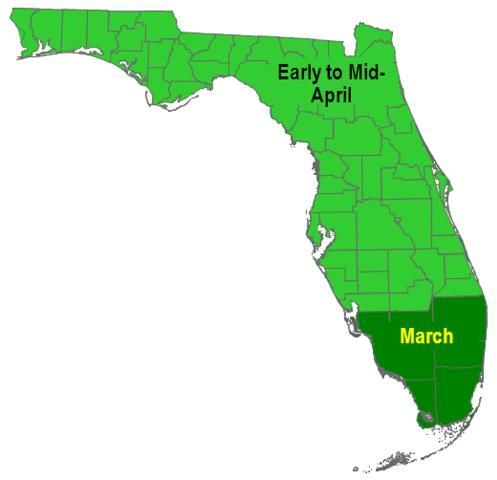
c. Seeding Rate (Seed Number Per Acre vs. Pounds Per Acre)
Sudangrass and sorghum x sudan hybrids can be broadcast (B) or drilled. Hybrid forage sorghum (single cut) is usually planted in wide (20–36 inch) rows (R) to facilitate harvest and in-season field operations. The planter may need special plates or other modifications to handle sorghum seed. Recommended seeding rate for forage sorghum intended for silage use in Florida is 6–8 lb per acre (R) and 10–15 lb per acre (B). Recommended seeding rate for sorghum x sudan hybrids in Florida is 8–20 lb per acre (R) and 25–30 lb per acre (B). Excessive seeding can increase lodging (Table 4).
Table 4. Seeding rate for sorghums in Florida.
To calculate seeds per acre:
Equation 1.
To calculate seeds per foot of row:
Equation 2.
Table 5. Number of seeds per pound for different sorghum types.
d. Plant Population/Row Width
Forage sorghum yields tend to increase with narrower rows. Final plant density should be adjusted to growth conditions in your region. In drier regions or regions with sandy soils that hold little water, planting density should be on the low end of the recommended range. Forage sorghums tend to be planted at relatively high densities to improve quality, but for BMR forage sorghums this is unnecessary. Recommended plant populations for BMR are 60,000–80,000 plants per acre (rows, irrigated), 70,000–100,000 plants per acre (drilled, irrigated), 40,000–80,000 plants per acre (rows, rain fed), and 50,000–80,000 plants per acre (drilled, rain fed).
e. Tillage Practices
Preparation of soil for planting generally includes plowing and harrowing. Plowing can be done in the fall or just before planting. In areas where soil erosion due to wind and water are a concern, conservation tillage may be appropriate. Sorghum also does well in no-till production systems. Studies have shown no consistent differences in biomass yield when comparing no-till and conventional tillage practices. No-till has proven beneficial for yields in continuous sorghum rotations.
f. Planting Practices
Sorghum planting practices should match intended usage. Forage sorghum used in pastures can be planted by drill, a broadcast seeder, or in rows.
g. Seeding Depth
Recommended planting depth for hybrid forage sorghum is 1–1 1/2 inches for sandy soils and 3/4–1 1/4 inches in heavy soils. Seeds should be planted in moist soil and can be planted slightly deeper if necessary to reach moisture. However, shallower planting will result in quicker emergence and minimize disease problems that can be associated with delayed emergence.
Sudangrass and sorghum x sudan hybrids should be planted no deeper than 1 inch, specifically 1/4–1/2 in heavy soils and 1/2–3/4 in sandy soils.
3. Fertilizer Requirement
a. Timing of Application
For row plantings, preplant fertilization requirements can be broadcast and plowed down before planting. Alternatively, fertilizer can be applied at time of planting in continuous bands 2–3 inches to each side and 2–3 inches below the seed. For drill or broadcast plantings, the initial fertilization should be broadcast and disked into the soil ahead of planting, making sure not to place fertilizer in direct contact with the seed. Splitting the total fertilizer that is to be applied equally between an "at-planting" application and one or more additional applications during the growing season is highly recommended. This increases nutrient-use efficiency and reduces the risk of nutrient runoff, leaching, or gaseous loss. When the crop is produced for silage, the second application should be applied when the crop reaches a height of about 12 inches (and 24 inches if split three times). If the crop is grazed or cut for hay, split applications should be made after each grazing/harvest event.
b. Soil/Plant Testing for Nutrition
Adequate soil fertility is necessary for optimum yield, and soil testing is the means to evaluate soil fertility. Based on removal of the crop, 120 lb nitrogen (N; supplied as ammonium nitrate), 65 lb phosphorous (P; supplied as P2O5), and 120 lb potassium (K; supplied as K2O) are recommended for 21-ton-per-acre yield potential. Adjust by 30-15-30 pounds for each 4-ton-per-acre change in yield goal.
As with all crops, an ample supply of available nutrients must be provided for optimal forage sorghum production. Maintaining optimum soil fertility is critically important for ensuring good establishment, persistence, pest tolerance, drought tolerance, forage quality, yields, and, most importantly, economic returns. If any nutrient is deficient, problems in one or all of these areas can occur. Thus, it is critical that a good soil fertility program be the basis of the management system for forage sorghums.
A soil test is the best tool for assessing soil fertility. Soil testing is a chemical analysis that reveals any soil fertility issues that may be limiting production. The key to soil testing is to ensure that the sample is representative of the area of interest. At the very least, each field should be sampled separately. Soil pH and some nutrients often will vary with soil type. Fields with substantially different soil types should be sampled separately within major soil types.
The soil sample analysis provides a guideline for the amount of lime or fertilizer needed to correct deficiencies or imbalances in soil pH or available nutrients. These amounts are determined by the specific needs of the crop being grown. Furthermore, soil test recommendations from land grant universities are based on decades of scientific studies. Thus, by regularly testing soil and following the recommendations, soil fertility can be maintained at levels that result in optimum productivity. In this section, the importance of several essential elements is briefly conveyed, and generalized recommendations are relayed. However, people should follow the soil test recommendations for their state or region, as they have been refined for those conditions.
c. Nitrogen
Rate of N application will vary depending on soil quality and production goals. For each green ton (600 dry lb) of sorghum forage produced, approximately 9 lb of N are removed. With good management, some varieties can produce 40 or more green tons (12 dry tons) per acre from a single crop.
In general, forage sorghum should receive 120–150 lb N per acre for a yield goal of 20–25 green tons (6–7.5 dry tons) per acre. Irrigated forage sorghums should receive up to 30% more N. When calculating N needed, consider residual soil N, soil organic matter, N content in irrigation water, and manure applications. Reduce the N rate by 20–40 lbs per acre following peanuts and soybeans and by 80–100 lbs per acre following alfalfa or a legume winter cover crop that is allowed to bloom.
General recommendations are that one-fourth to one-third of the total recommended N rate per acre should be applied just prior to or at planting. For silage production, sidedress or sidedress the remaining N according to production goals when the crop reaches 18–24 inches (approximately 4–6 weeks after planting). If a second (ratoon) crop is attempted, fertilize at half the original rate when plants are 12–24 inches in height. For grazing purposes apply 30–50 lb N per acre after each grazing period or harvest, as needed.
d. Phosphorus
Sorghum response to P is typically only seen in soils with very low available P. Apply the entire soil-test-recommended P fertilizer in a preplant or planting application. In acid soils with low available P, banding P fertilizer near the furrow at planting may be warranted.
e. Potassium
Potassium availability for sorghum production is important, as K is an essential element for the plant and markedly improves disease and pest resistance. The addition of K is crucial, since removal rates by forage sorghum can be relatively high. The most common K formulation (muriate of potash or potassium chloride [KCl]) has also been shown to increase stalk strength and thus plays an important role in minimizing lodging. Recent evidence suggests that the chloride (Cl-) in KCl contributes to lodging resistance. If the forage sorghum production is intended for silage use, apply 30% of the soil-test-recommended K fertilizer as a preplant broadcast or as a starter application at planting. Top-dress or side-dress the remaining 70% of the K fertilizer when the crop reaches 18–24 inches (approximately 4–6 weeks after planting). If a second (ratoon) crop is desired, fertilize at half the original rate. For sudangrass or sorghum x sudan hybrid crops that are intended for grazing, apply 50% of the soil-test-recommended K fertilizer as a preplant broadcast or starter application at planting. Apply the remaining 50% of the K fertilizer after the first grazing.
f. Sulfur
Fertilizer additions to forage sorghums should contain sufficient S to supply 10 lbs of S per acre. Since S is highly leachable, especially on deep sands, application of S with postplant nitrogen applications may improve efficiency.
g. pH
Sorghum is tolerant to a wide range of soil pH conditions (soil pH range from 5.5 to 8.5), but the optimum pH is 6 to 6.5. Soils in the southeastern United States are typically low in soil pH. Low soil pH can result in a poorly developed root system. Additionally, low soil pH alters the availability of many of the essential nutrients. Low soil pH reduces the nutrient-use efficiency of major nutrients like N, P, K, and S, and it frequently induces deficiencies (or toxicities) of minor nutrients like molybdenum (Mo), boron (B), zinc (Zn), and manganese (Mn). For these reasons, care should be taken to keep soil pH in the optimum range.
h. Minor/Trace Nutrients
Most minor nutrients should be available to the plant if soil pH values are in the optimum range. However, some soils may be deficient in one or more of the minor nutrients. The addition of minor nutrients should be applied according to soil test results.
Table 6. Nutrient recommendations.
4. Water Management
a. Water-Use Requirements
Sorghum will respond to irrigation like most crops. However, due to its low market value, it is seldom irrigated. The increase in sorghum yield due to the added moisture may not pay for the irrigation costs. Forage sorghum is often grown after irrigated corn since irrigation is available from corn.
Sorghum is able to grow and survive in regions where rainfall is relatively low or where frequent dry periods occur. Still, growth and yield responses are closely related to available water. Limited data for water-use requirements are available in the southeastern United States. Water-use estimates reported elsewhere typically range from about 15–30 inches of water to produce a forage sorghum crop. Across this range of water use, a recent study using a BMR forage sorghum near Bushland, Texas, showed an increase in yield of approximately 0.83 tons per acre for each additional inch of water use, from about 10 tons per acre at 15 inches of water use to about 22 tons per acre at 30 inches of water use. Another recent study from the same location comparing sorghum and corn silage production reported lower seasonal crop water use by sorghum (19.3 compared to 26.4 inches). However, yields-per-unit-water-use were similar among sorghum and corn. These findings indicate that sorghum can be produced with less water, but yields will be commensurate with water use. So, in regions where water availability is low, irrigation is not available, or water use is restricted, sorghum offers an attractive alternative for forage production, but lower yields must be expected.
b. Timing of Moisture
Soil moisture is critical for germination. Water stress during booting, flowering, and grain fill can greatly reduce grain yields for grain sorghums. Other than germination, forage sorghums do not have the growth stages where water availability is critical, so they tend to use water more efficiently, and timing of moisture is less of a concern. As a result, forage sorghum planted in June in the southeastern United States will need little irrigation because rainfall is generally sufficient to produce a good crop. However, earlier plantings will run into moisture deficits, and irrigation will greatly increase yields.
5. Weed Control
Critical in sorghum production is the removal of competition during the initial stages of development. It should not be planted in fields that are infected with johnsongrass. Broadleaf weeds can be effectively controlled through chemical applications.
For herbicide recommendations (pre- and postemergence), please refer to the IFAS Extension publication Weed Management in Sorghum (https://edis.ifas.ufl.edu/wg002).
6. Sorghum Diseases
Forage sorghums in Florida can be susceptible to several diseases. Potential diseases include anthracnose (major leaf disease), zonate leaf spot, rough spot, northern corn leaf blight, bacterial leaf stripe, rust, head mold, and ergot. Of these, ergot is the only disease that has caused significant damage on forage sorghum in the southeastern United States in the past few years. In fact, it is a rare occurrence when one or more of the diseases cause severe damage or economic loss in forage sorghum. Moreover, no fungicides are labeled for use on forage sorghum plantings. Disease management in forage sorghum plantings is largely mitigated by proper planting time and crop rotation.
Anthracnose (Colletotrichum sublineolum)
Symptoms
- Elliptical black lesions, >5 mm in diameter that develop circular, straw-colored centers with wide margins that may vary in color from reddish to blackish purple (Figure 2).
- On some cultivars, disease may defoliate the plant; in severe cases, plants will die before they reach maturity.
- Can also occur on stalks (where it is known as stalk or red rot), panicles (head rot), and the grain.
- Favorable disease conditions are frequent rains and warm nights.
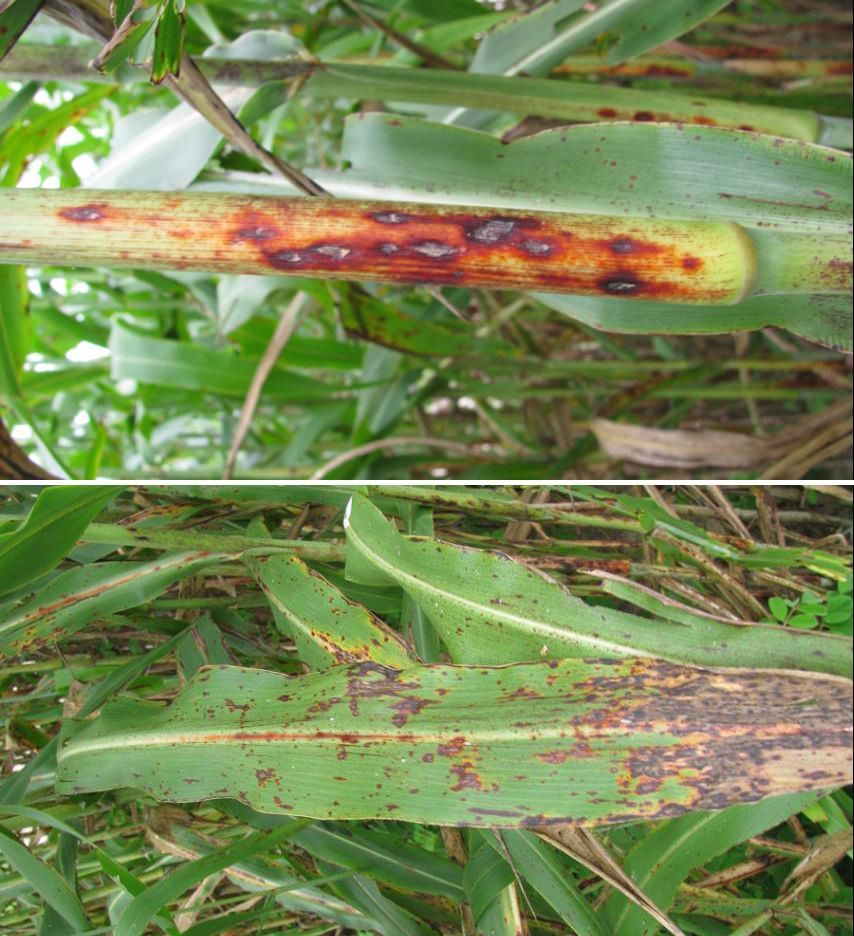
Credit: John Erickson, UF/IFAS
Management
- Crop rotation
- Cultivar resistance (good resistance in forage sorghums).
- Suppression of grass weeds and volunteers around field
- Adjust planting date (mid-April to mid-May to avoid late-summer disease pressure in North Florida).
Head Mold (Fusarium, Curvularia, Colletotrichum, Alternaria, and Bipolaris spp.)
Symptoms
- Florida's warm, wet summer weather is conducive to head mold.
- Infection by some Fusarium spp. can produce toxins that are poisonous to livestock.
- Abnormal colorations and moldy growths on the head (Figure 3).
- Fusarium spp. cause white-pink colors on the outside of flowers and seed.
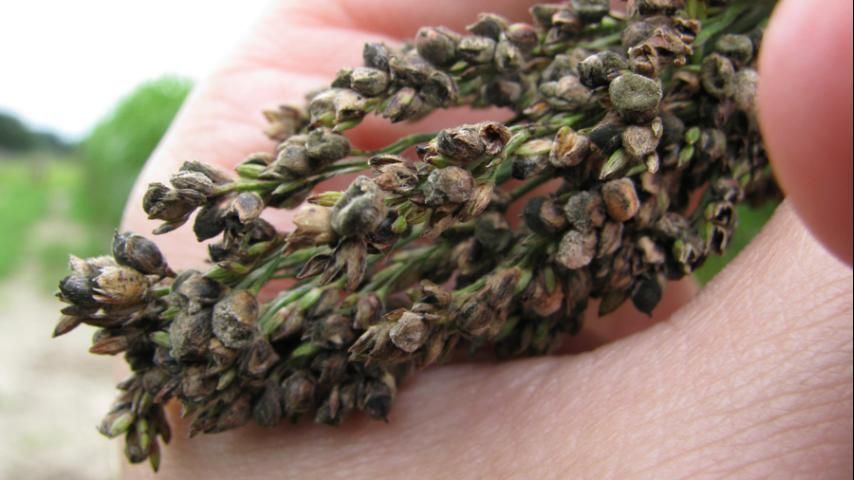
Credit: John Erickson, UF/IFAS
Management
- Can be severe in some plantings, especially in varieties with tight heads or panicles or some non-bird-resistant types of sorghum.
- Red seed coats provide some resistance to this disease complex.
- Plant at a time of year when flowering initiates during drier months, reduce insects such as sorghum midge, use resistant varieties.
Ergot (Claviceps africana)
Symptoms
- Initial symptom is appearance of sphacelia, which is a white swelling of the seed (Figure 4).
- Sphacelia produce honey dew and spores.
- Black sclerotia develop in place of the seed and give an overall black, sooty appearance to the seedhead.
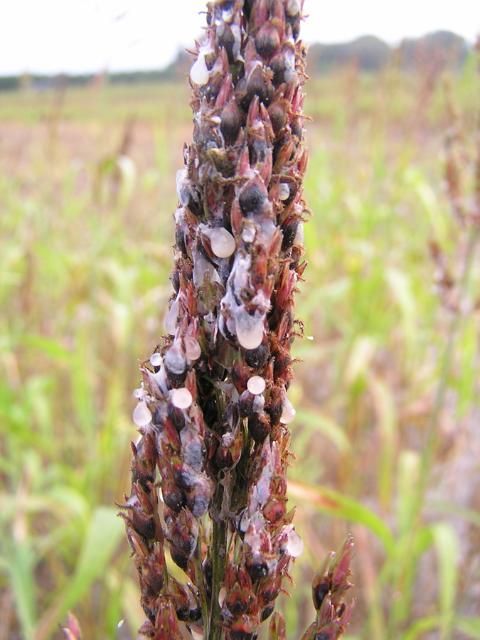
Credit: Curtis Rainbolt, UF/IFAS
Management
- Especially problematic on later plantings or plantings that mature later.
- Male, sterile forage sorghum is also at heightened risk for ergot.
- An active infection cannot be cured. Avoid late planting and utilize cultivar resistance.
- Early applied fungicides can be effective but may be cost prohibitive.
Bacterial Leaf Stripe (Pseudomonas andropogonis)
Symptoms
- Reddish-purple to tan-brown, somewhat-linear spots (Figure 5).
- Lesions tend to be interveinal and may attain lengths of 8" with lesion color uniform throughout.
- Favors warm, wet weather conditions.

Credit: University of Georgia College of Agriculture and Environmental Sciences.
Management
- Not a major problem in Florida.
- Most forage sorghum varieties have tolerance and/or resistance to this bacterial disease.
- Crop rotation.
- Resistant varieties.
- Plowing down old crop debris.
- Avoid field operations when the field is wet.
Northern Corn Leaf Blight (Exserohilum turcicum); pathogen also known as Bipolaris spp. or Helminthosporium spp.
Symptoms
- Lesions are cigar-shaped, tan to brown in the center (Figure 6).
- Lesions are sometimes surrounded by a dark, brown-reddish purple border or narrow band of water soaking.
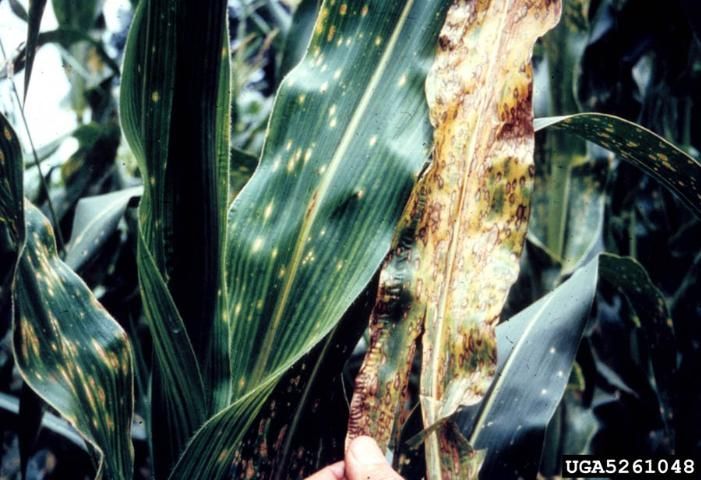
Credit: Division of Plant Industry Archive, Florida Department of Agriculture and Consumer Services, Bugwood.org
Management
- Rarely seen disease on forage sorghum in Florida.
- Resistant varieties.
- Crop rotation with nongrass crops.
- Bury old sorghum crop debris.
- Destroy johnsongrass and volunteers of susceptible crops in the vicinity.
Rust (Puccinia spp.)
Symptoms
- Pathogen produces elongated, raised pustules in leaves and in outer tissue of the peduncle (head stem).
- Pustules in leaves are <1/8" long and often surrounded by a reddish-brown to tan halo (Figure 7).
- Pustules in peduncle may be longer and linear or within oval, red to brown lesions. Within raised pustule, a red to orange-brown mass of spores will be exposed if the pustule covering has ruptured.
- Spores are easily dispersed by wind. Pathogen also produces telial lesions, which are dark brown to black in color.
- Favors cool, wet conditions.
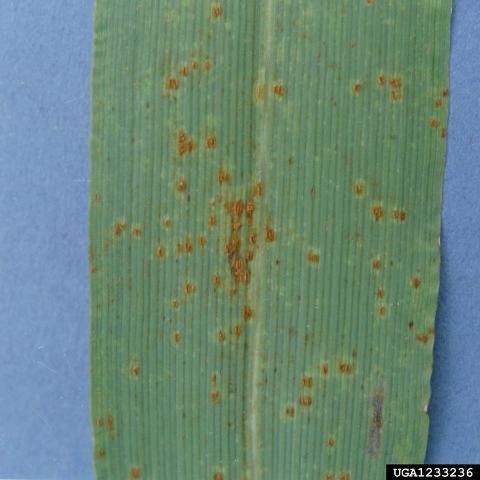
Credit: Clemson University, USDA Cooperative Extension Slide Series, Bugwood.org
Management
- Has not been a major problem in Florida.
- Resistant varieties.
- Management of rust-harboring weed species, such as red sorrel.
Zonate Leaf Spot (Gloeocercospora sorghi)
Symptoms
- Early lesions can be similar to Anthracnose.
- Larger lesions have distinctive, circular alternating bands of white or tan with outer bands of reds, purples, or browns (Figure 8).
- Disease favors frequent rains and warm nights.
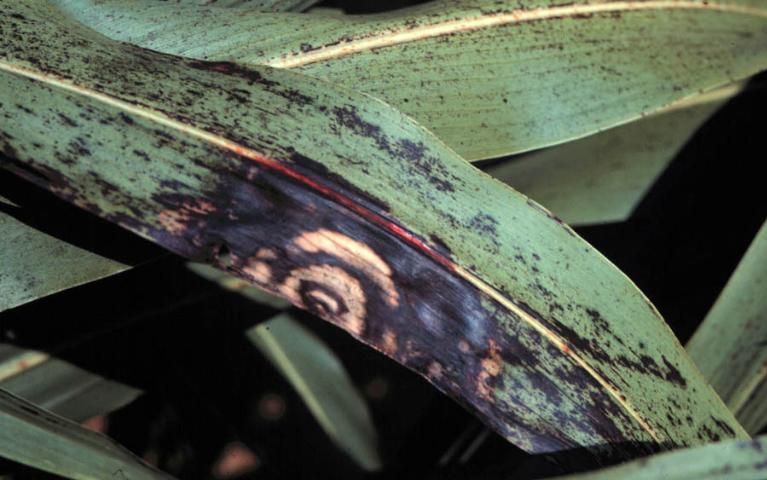
Credit: University of Georgia College of Agriculture and Environmental Sciences
Management
- Historically, has not been a major problem in Florida.
- Management includes crop rotation.
- Use resistant varieties.
- Bury old crop debris by plowing.
- Avoid field tasks when leaves are wet.
Further Information on Disease Symptoms and Management
- The University of Georgia has a plant pathology website that is a disease library and includes information on sorghums about 2/3 of the way down the page: http://plantpath.caes.uga.edu/extension/DiseaseLibrary.html.
7. Sorghum Insects and Nematodes
a. Insects
A number of insect pests cause economic damage to sorghum plantings in the southeastern United States. Many of the insects that attack corn also can attack sorghum. Three insect pests that are commonly found on sorghum in the southeastern United States are sorghum midge (Contarinia sorghicola [Coquillett]), greenbug (Schizaphis graminum [Rondani]), and chinch bug (Blissus insularis). A description and picture of these three insects can be found below.
Sorghum Midge (Contarinia sorghicola [Coquillett])
Description and Damage
Sorghum midge is the most damaging of the pests. It is a small (1.3 mm), orange-red fly with a yellow head, brown antennae and legs, and gray wings (Figure 9). The female fly lays her eggs in the panicle of the sorghum plant, between the glumes of open (flowering) spikelets. Because of its short generation time (2 weeks), high infestation rates can occur. Infestation with sorghum midge will result in reduced seed production.
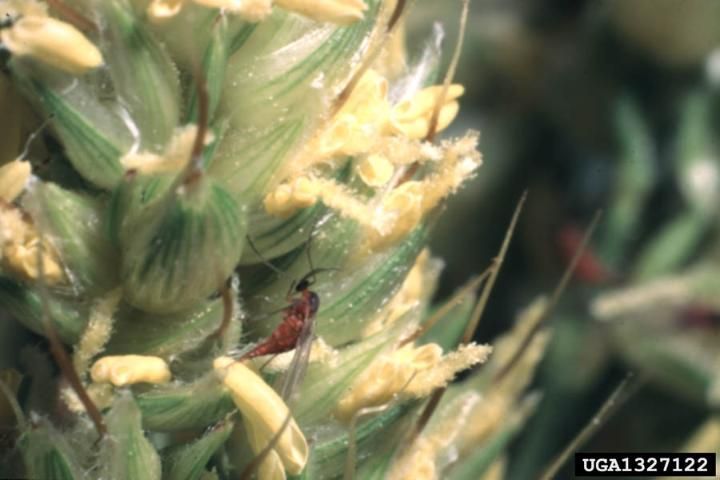
Credit: Alton N. Sparks, Jr., University of Georgia, Bugwood.org
Management
Damage due to sorghum midge can be reduced by planting early and by uniform panicle emergence, which allows limited opportunity for later generations to thrive on more slowly maturing panicles.
Midge-resistant hybrids and application of insecticides can further reduce damage.
Greenbug (Schizaphis graminum [Rondani])
Description and Damage
Greenbugs are aphids and have a light green or dark green appearance (Figure 10). Adults are approximately 1.6 mm long.

Credit: Guy Bishop, University of Idaho/Susan Halbert, Florida Department of Agriculture and Consumer Services
They live on the underside of the leaves and produce a sticky residue known as honeydew.
Damage to sorghum results when the aphids suck juice out of the plant and inject toxins. The toxins will damage the leaves and weaken the plant, resulting in reduced stand, lodging, and yield losses. Greenbug populations generally decline towards the end of the season because of the parasitic braconid wasp (Lysiphlebus testaceipes [Cressoni]).
Management
Damage due to greenbugs can be controlled by organophosphorus insecticides, which have to be applied at low rates to avoid damaging other insects.
Chinch Bug (Blissus insularis)
Description and Damage
Chinch bugs affect mostly seedlings. Adult chinch bugs are 4.2 mm in length and are dark in color with white forewings (Figure 11 B). The larvae are red to black with a light stripe across the abdomen (Figure 11 A). The eggs are laid behind the sheath of the lower leaves. With a 30–40-day life cycle, it is common to have 2–3 generations of chinch bugs per growing season.
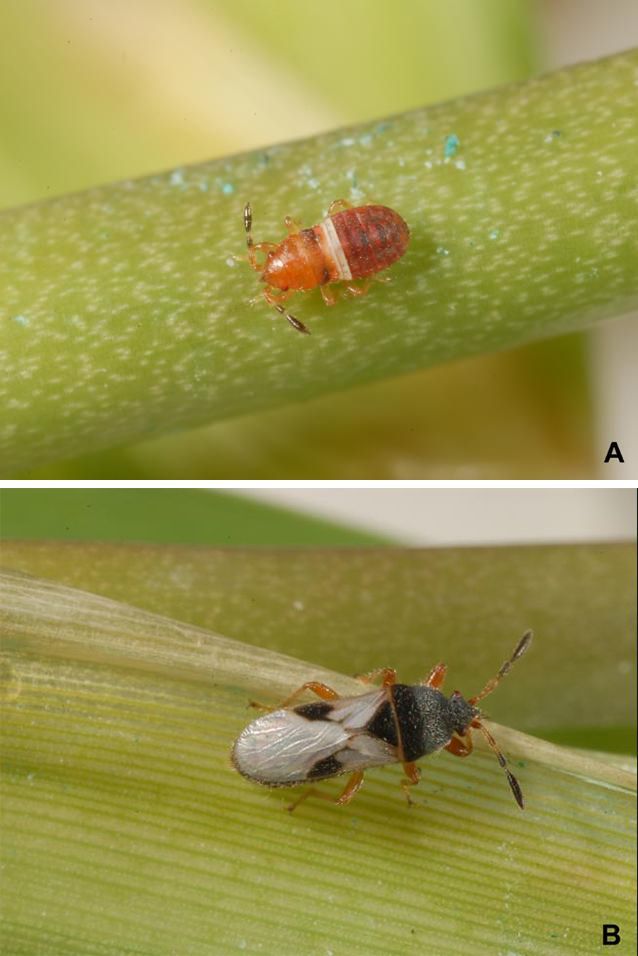
Credit: Lyle Buss, UF/IFAS
Both young and adult chinch bugs suck juice from the stem and roots, resulting in weakened and stunted plants and yield losses.
Management
Chinch bug damage can be limited by planting sorghum early and at high density. Insecticides can be used to control chinch bugs during the early stages of plant development.
Additional Information
Sorghum midge: https://texasinsects.tamu.edu/sorghum-midge/
Greenbug: https://texasinsects.tamu.edu/greenbug-aphid/
Chinch bug: https://texasinsects.tamu.edu/chinch-bug/
b. Nematodes
Many plant-parasitic nematodes that parasitize other crops also attack sorghum and sorghum x sudan hybrids and can limit yields when sorghum crops are planted back to back. However, out of the many plant-parasitic nematodes, Pratylenchus spp. and Belonolaimus spp. seem to be responsible for yield reduction in most hybrids. These nematodes have been found to build up to levels that can destroy sorghum root systems and cause a crop failure on well-drained sandy soils. This can occur in just two seasons where spring grain sorghum was followed by rye for grazing in the winter, then followed by summer silage sorghum the second year. Proper crop rotation is critical to maintain optimum sorghum productivity.
Sorghums should be rotated with broad-leaved crops between growing seasons. Examples of broad-leaved crops might include southern peas, cotton, soybean, potatoes, sweet potatoes, cucurbits, and solanaceous crops.
Pratylenchus (Pratylenchus sp.)
Description and Damage
- Yellowing and stunting of top growth
- Lesions on roots
- Loss of primary roots and severe pruning of roots
8. Preharvest Desiccants for Sorghum
Preharvest desiccants are commonly used in grain sorghum. For forage sorghums, no preharvest desiccants are labeled, and those that are commonly used in grain sorghum have harvest interval restrictions that make them impractical for forage use (i.e., the feeding restriction after application is too long for these products to be feasible).
9. Harvesting Forage Sorghum
The time of harvest can be critical to sorghum yields. Silage sorghums should be harvested at soft-dough stage for maximum dry matter yield and forage quality. Green-chop sorghums should be harvested preboot for repeated cuttings. Ratoon crops of either silage or forage sorghums should leave at least two intact nodes (counting from the soil surface upward, usually over 6 inches) for regrowth and need an application of nitrogen fertilizer. Grain should dry sufficiently in the field, but if left longer than necessary, bird predation, ergot, and other diseases in the seedhead can significantly reduce yield. Syrup sorghums should be harvested at peak sugar content (highest °Brix, measured from juice expressed at the 4th node from the soil level).
10. Drying and Storage of Forage Sorghum
If harvesting sudangrass or sorghum x sudan hybrids, it is best to use a roller-crimper mower-conditioner. Research in Georgia has indicated that it takes sudangrass or sorghum x sudan hybrids at least 1–2 days longer to dry to hay-making moistures than the perennial grasses conventionally used as hay crops in the southeastern United States. Failure to use a roller-crimper mower-conditioner may add 3–4 additional days to this drying time.
11. Marketing Strategies for the Southeastern United States
Sorghum silage hybrids can produce high fresh weight yields of silage. In northeast Florida on a wet flatwoods soil site, highest crude protein, total digestible nutrients and 13 fresh weight yields were obtained when the silage hybrids were harvested at the soft-dough stage of maturity with an intermediate nitrogen rate. Custom-chopping silage for local dairies and feed lots is an option. Large enough equipment is now available to cut, allow wilting to 50%–60% moisture, roll, and bag for ensilaging in 1,000-pound plastic-wrapped units. The wrapped units can be stored and transported when needed by livestock producers.
The production of sorghum x sudangrass hybrids and sudangrass for grazing is directly tied to beef cattle and dairy production systems. These grasses are efficient users of nutrients, making them adapted to capturing nutrients from lagoon spray fields in the form of forage, which can again be recycled through the ruminant animal. Pastures of these grasses could be used to raise replacement beef heifers and dairy cattle. Backgrounding beef calves on a contract basis might be an option. The movement to buy locally raised beef and pasture-raised beef could be exploited, although this is a small, currently emerging market.
Acknowledgements
The authors would like to thank the United Sorghum Checkoff Program for facilitating the production of this publication.
Selected References
Carmi, A., Y. Aharoni, M. Edelstein, N. Umiel, A. Hagiladi, E. Yosef, M. Nikbachat, A. Zenon, J. Miron. 2006. Effects of irrigation and plant density on yield, composition and in vitro digestibility of a new forage sorghum variety, Tal, at two maturity stages. Animal Feed Science and Technology 131:121-133. https://doi.org/10.1016/j.anifeedsci.2006.02.005
Dahlberg, J. 2000. Classification and characterization of sorghum. pp 99-130. In C. W. Smith and R. A. Frederiksen (ed.) Sorghum origin, history, and production. John Wiley Publishers, New York, NY.
Ferrell, J. A., G. E. MacDonald, and B. J. Brecke. 2007. Weed management in sorghum – 2009. EDIS Document SS-AGR-06, Florida Cooperative Extension Service, University of Florida. Available at: https://edis.ifas.ufl.edu/wg002
Fribourg, H., and J. C. Walter. 2002. Summer annual grasses (grain) and forage sorghums, sudangrass, and millets. In: Forage Information System.
Hancock, D. W. 2009. Sorghums. Univ. of Georgia Crop and Soil Sci. Dept. Fact Sheet CSS-F025. Available at: http://georgiaforages.caes.uga.edu/species-and-varieties/warm-season/sorghums.html
Miron, J, E. Zuckerman, G. Adin, M. Nikbachat, E. Yosef, A. Zenou, Z. G. Weinberg, R. Solomon, and D. Ben-Ghedalia. 2007. Field yield, ensiling properties and digestibility by sheep of silages from two forage sorghum varieties. Animal Feed Science and Technology 136:203-215. https://doi.org/10.1016/j.anifeedsci.2006.09.001
Newman, Y. C. 2009. Sorghum. In Forages of Florida website. http://agronomy.ifas.ufl.edu/ForagesofFlorida/detail.php?sp=Sorghum&type=G.
Stromberg, E., Phipps, P. M., Grybauskas, A. P., and R. P. Mulrooney. 2009. Diseases and Nematodes: Corn and Sorghum. Field Crops 2009.
Unger, P. W. 1988. Grain and forage sorghum production with no-tillage on dryland. Agronomy Journal 80:193-197. https://doi.org/10.2134/agronj1988.00021962008000020011x